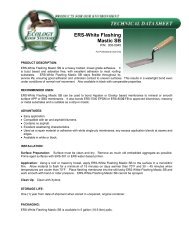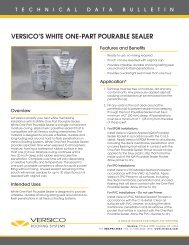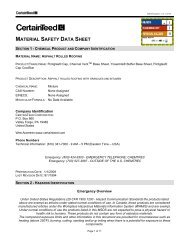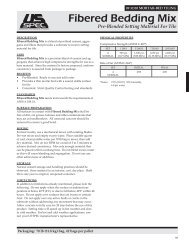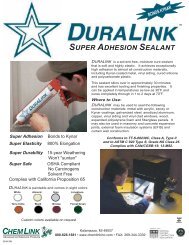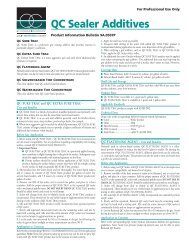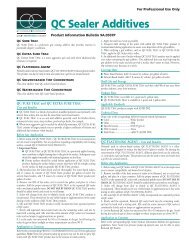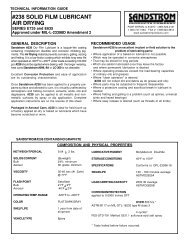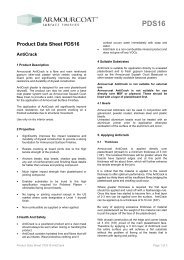Simpson Anchors - Anchoring and Fastening Systems - BuildSite.com
Simpson Anchors - Anchoring and Fastening Systems - BuildSite.com
Simpson Anchors - Anchoring and Fastening Systems - BuildSite.com
You also want an ePaper? Increase the reach of your titles
YUMPU automatically turns print PDFs into web optimized ePapers that Google loves.
C-SAS-2009 © 2009 SIMPSON STRONG-TIE COMPANY INC.<br />
EXAMPLE CALCULATION Mechanical <strong>Anchors</strong> (Traditional ASD)<br />
Example calculation for a group of (2) Titen HD ® anchors<br />
using ASD:<br />
Design a connection <strong>com</strong>prised of two (2) ³⁄₄" diameter Titen HD ®<br />
anchors installed in the face of an 8" normal weight grouted CMU wall as<br />
shown. The anchor group has an applied tension load of 600 lbs. <strong>and</strong> an<br />
applied shear load of 500 lbs. acting simultaneously.<br />
ADDITIONAL DATA:<br />
• Embedment depth = 5¹⁄₂"<br />
• Spacing = S act = S1 = 8".<br />
• Critical spacing for ³⁄₄" dia. anchor at<br />
embedment = S cr = 12".<br />
• S act < S cr therefore use spacing reduction factor for S1.<br />
• End distance = C act = C1 = 4"<br />
Edge distance = C act = C2 = 12"<br />
• Critical edge distance = C cr = 12".<br />
• Critical end distance = C cr = 12".<br />
• C1 < C cr , therefore use perpendicular-to-edge reduction<br />
factor for C1.<br />
• C2 > C cr , therefore no edge reduction<br />
factor for C2.<br />
SOLUTION:<br />
TENSION<br />
Determine uninfl uenced allowable tension load in the face of an 8"<br />
normal wt. concrete grouted CMU wall:<br />
Uninfl uenced allowable tension = 1,600 lbs.<br />
Calculate reduced effi ciency factors for Edge Distance:<br />
C act = C1 = 4"<br />
C act = C2 = 12"<br />
f cC1 = 0.66 = Load adjustment factor (page 130)<br />
Calculate reduced effi ciency factor for spacing:<br />
S act = S1 = 8"<br />
f sS1 = 0.67 = Load adjustment factor (page 130)<br />
Calculate allowable tension load per anchor:<br />
Allowable tension = (uninfl uenced allowable tension) (f cC1 )(f sS1 )<br />
Allowable tension = (1,600 lbs.)(0.66)(0.67)= 708 lbs. per anchor<br />
For a group of 2 anchors the <strong>com</strong>bined allowable tension value is:<br />
= (2 anchors)(708 lbs./anchor) = 1,416 lbs. > 600 lbs.<br />
(design tension) O.K.<br />
SHEAR<br />
Determine uninfl uenced allowable shear load in<br />
the face of an 8" normal wt. concrete grouted CMU wall:<br />
Uninfl uenced allowable shear = 3,000 lbs.<br />
Calculate reduced effi ciency factor for end distance:<br />
C act = C1 = 4"<br />
C act = C2 = 12"<br />
f cC1 = 0.21 = Load adjustment factor (page 130)<br />
Calculate reduced effi ciency factor for spacing:<br />
S act = S1 = 8"<br />
f sS1 = 0.75 = Load adjustment factor (page 130)<br />
Calculate allowable shear load per anchor:<br />
Allowable shear = (uninfl uenced allowable shear) (f cC1 )(f sS1 )<br />
Allowable shear = (3,000 lbs.)(0.21)(0.75) = 473 lbs. per anchor<br />
For a group of 2 anchors the <strong>com</strong>bined allowable shear value is:<br />
= (2 anchors)(473 lbs./anchor) = 945 lbs. > 500 lbs.<br />
(design shear) O.K.<br />
Would you like help with these calculations?<br />
Visit www.simpsonanchors.<strong>com</strong> to download the<br />
<strong>Simpson</strong> Strong-Tie ® Anchor Designer software.<br />
Two Anchor Layout<br />
C2 = 12"<br />
600 lb.<br />
Tension<br />
C1 = 4" S1 = 8"<br />
500 lb.<br />
Shear<br />
The allowable tension (or shear) value for a group<br />
of anchors is equal to the lowest (minimum) tension<br />
(or shear) value for a single anchor within the group<br />
multiplied by the number of anchors within the group.<br />
CHECK COMBINED TENSION AND SHEAR INTERACTION:<br />
For the Titen HD ® in grouted CMU, use the straight-line method<br />
(n = 1, see Figure 1) when calculating the interaction of both<br />
tension <strong>and</strong> shear upon the anchor per the following equation:<br />
(Design shear/Allowable shear) n + (Design tension/Allowable tension) n<br />
≤ 1.0, n = 1<br />
Design shear (V) = 500 lbs.<br />
Allowable shear (V all ) = 945 lbs.<br />
Design tension (T) = 600 lbs.<br />
Allowable tension (T all ) = 1,416 lbs.<br />
(600/1,416) 1 + (500/945) 1 = 0.95 ≤ 1.0 O.K.<br />
Figure 1<br />
Note: The elliptical method permits greater<br />
allowable tension <strong>and</strong> shear loads to be used<br />
than the straight-line method.<br />
23



